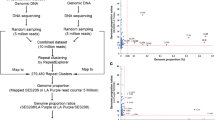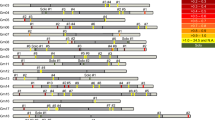Abstract
The complete sequence of the first retrotransposon isolated in Vitis vinifera, Gret1, was used to design primers that permitted its analysis in the genome of grapevine cultivars. This retroelement was found to be dispersed throughout the genome with sites of repeated insertions. Fluorescent in situ hybridization indicated multiple Gret1 loci distributed throughout euchromatic portions of chromosomes. REMAP and IRAP proved to be useful as molecular markers in grapevine. Both of these techniques showed polymorphisms between cultivars but not between clones of the same cultivar, indicating differences in Gret1 distribution between cultivars. The combined cytological and molecular results suggest that Gret1 may have a role in gene regulation and in explaining the enormous phenotypic variability that exists between cultivars.




Similar content being viewed by others
References
Baumel A, Ainouche M, Kalendar R, Schulman AH (2002) Retrotransposons and genomic stability in populations of the young allopolyploid species Spartina anglica C E Hubbard (Poaceae). Mol Biol Evol 19:1218–1227
Belyayev A, Raskina O, Nevo E (2001) Chromosomal distribution of reverse transcriptase-containing retroelements in two Triticeae species. Chromosome Res 9:129–136
Bretó MP, Ruiz C, Pina JA, Asíns MJ (2001) The diversification of Citrus clementina Hort ex Tan, a vegetatively propagated crop species. Mol Phylogenet Evol 21:285–293
Britten RJ, Davidson EH (1969) Gene regulation for higher cells: a theory. Science 165:349–357
Flavell RB (1986) Repetitive DNA and chromosome evolution in plants. Philo Trans R Soc of Lond B Biol Sci 312:227–242
Friesen N, Brandes A, Heslop-Harrison JS (2001) Diversity, origin and distribution of retrotransposons (gypsy and copia) in Conifers. Mol Biol Evol 18:1176–1188
Fukui KN, Suzuki G, Lagudah ES, Rahman S, Appels R, Yamamoto M, Mukai Y (2001) Physical arrangement of retrotransposon-related repeats in centromeric regions of wheat. Plant Cell Physiol 42:189–196
Haas HU, Alleweldt G (2000) The Karyotype of grapvine (Vitis vinifera L). Acta Hort (ISHS) 528:249–258
Hodgetts R (2004) Eukaryotic gene regulation by targeted chromatin re-modelling at dispersed, middle-repetitive sequence elements. Curr Opin Genet Dev 14:680–685
Jianxin MA, Katrien MD, Bennetzen JL (2004) Analyses of LTR-retrotransposon structures reveal recent and rapid genomic DNA loss in rice. Genome Res 14:860–869
Jones GH, Heslop-Harrison JS (2000) Arabidopsis, a practical approach. Wilson ZA (ed) Oxford University Press, Oxford, pp 105–124
Kalendar R, Crob T, Regina M (1999) IRAP and REMAP: two new retrotransposon-based DNA fingerprinting techniques. Theor Appl Genet 98:704–711
Kazazian Jr HH (2004) Mobile elements: Drivers of genome evolution. Science 303:1626–1632
Kobayashi S, Goto-Yamamoto N, Hirochika H (2004) Retrotransposon-induced mutations in grape skin color. Science 304:982
Kumar A, Hirochika H (2001) Applications of retrotransposons as genetic tools in plant biology. Trends Plant Sci 6:87–134
Manninen O, Kalendar R, Robinson J, Schulman AH (2000) Application of BARE-1 retrotransposon markers to the mapping of a major resistance gene for net blotch in barley. Mol Gen Genet 264:325–34
Martins A, Carneiro LC, Gonçalves E, Magalhães N (2002) O que a Selecção das Castas Pode dar (e dá) aos Viticultores. Vititecnica 1:16–18
Miyao A, Tanaka K, Murata K, Sawaki H, Takeda S, Abe K, Shinzuka Y, Onosato K, Hirochika H (2003) Target site specificity of the Tos17 retrotransposon shows a preference for the insertion within genes and against insertion in retrotransposon-rich regions of the genome. Plant Cell 15:1711–1780
Pinto-Carnide O, Martín JP, Leal F, Castro I, Guedes-Pinto H, Ortiz J M (2003) Characterization of grapevine (Vitis vinifera L) cultivars from northern Portugal using RAPD and microsatellite markers. Vitis 42:23–26
Sandhu D, Kulvinder SG (2002) Gene containing regions of wheat and other grass genomes. Plant Physiol 128:803–811
SanMiguel P, Tikhonov A, Jin Y, Motchoulskaia N, Zakharov D, Melake-Berhan A, Springer PS, Edwards KJ, Lee M, Avramova Z, Bennetzen JL (1996) Nested retrotransposons in the intergenic regions of the maize genome. Science 274:765–768
Sanz-Alferez S, SanMiguel P, Jin YK, Springer PS, Bennetzen JL (2003) Structure and evolution of the Cinful retrotransposon family of maize. Genome 46:745–752
Schulman AH, Flavell AJ, Ellis TH (2004) The application of LTR retrotransposons as molecular markers in plants. Methods Mol Biol 260:145–173
Sefc KM, Lopes MS, Lefort F, Botta R, Roubelakis-Angelakis KA, Ibanez J, Pejic I, Wagner HW, Glossl J, Steinkellner H (2000) Microsatellite variability in grapevine cultivars from different European regions and evaluation of assignment testing to assess the geographic origin of cultivars. Theor Appl Genet 100:498–505
Thomas MR, Matsumoto S, Cain P, Scott NS (1993) Repetitive DNA of grapevine: classes present and sequences suitable for cultivar identification. Theor Appl Genet 86:173–180
Tomkins JP, Peterson DG, Yang TJ, Main D, Ablett ER, Henry RJ, Lee LS, Holton TA, Waters D, Wing RA (2001) Grape (Vitis vinifera L) BAC library construction, preliminary STS analysis, and identification of clones associated with flavonoid and stilbene biosynthesis. Am J Enol Vitic 52:287–291
Verriès C, Bès C, This P, Tesnière C (2000) Cloning and characterization of Vine-1, a LTR-retrotransposon-like element in Vitis vinifera L, and other Vitis species. Genome 43:366–376
Vershinin AV, Druka A, Alkhimova AG, Kleinhofs A, Heslop-Harisson JS (2002) LINE and gypsy-like retrotransposons in Hordeum species. Plant Mol Biol 49:1–14
Wong LH, Choo AKH (2004) Evolutionary dynamics of transposable elements at the centromere. Trends Genet 20:611–616
Acknowledgments
We would like to thank Antero Martins and Elsa Gonçalves for providing plant material. We would also like to thank Alexandra Castilho for helpful discussion. H. Sofia Pereira is funded by a postdoctoral fellowship (SFRH/BPD/14549/2003) from Fundação de Ciências e Tecnologia, Portugal.
Author information
Authors and Affiliations
Corresponding author
Additional information
Communicated by J.W. Snape
Rights and permissions
About this article
Cite this article
Pereira, H.S., Barão, A., Delgado, M. et al. Genomic analysis of Grapevine Retrotransposon 1 (Gret1) in Vitis vinifera . Theor Appl Genet 111, 871–878 (2005). https://doi.org/10.1007/s00122-005-0009-0
Received:
Accepted:
Published:
Issue Date:
DOI: https://doi.org/10.1007/s00122-005-0009-0




